Dutch ancestry originating from Denmark, to New York, to Ontario, and Nova Scotia.
The north American family name vanNostrand, originated from 1638. Two Dutch brothers emigrated from Nordstrand Island, Denmark in 1638, present day Germany. The name has been spelled in various forms since then, including: van Nostrand, van Nordstrandt, Van Norstrande or Van Nostrande, van Oostrand, Van Ostrande ,Oostrander, Ostrander, van Nostran.[7]etc.
Big Picture History
In 1638 our Dutch ancestors immigrated to “New Amsterdam” in North America, which is present day Long Island, New York City, via Amsterdam, Netherlands. Previously, they were living and working on Nordstrand Island, which was ruled by Denmark at that time. Currently it is a peninsula connected to the mainland in present day Germany. The Island of Nordstrand actually split into three islands in 1634, when a huge storm breached the dykes destroying many towns, leaving approximately 1,000 survivors of the original 6,000 inhabitants. Our ancestors were among the survivors.
The van Nostrand name is thought to have been taken when we arrived in North America. Translated it means “from the North Beach”. At that time there were very few families living in that part of the new world. Our ancestors then moved upstream along the Hudson River, to the Albany, NY area (250km). This is the place where Henry Hudson sailed his famous “Half Moon” ship. They settled in a colony there called “Rensselaerswyck”, which is present day Saratoga, New York. They probably started in Fort Orange. It was a time when “beaver pelts” were a common currency! Pelts were graded: Summer, Inferior, Good, whole, half, pieces.
Fort Orange Educational Guide | The New York State Museum (nysed.gov)
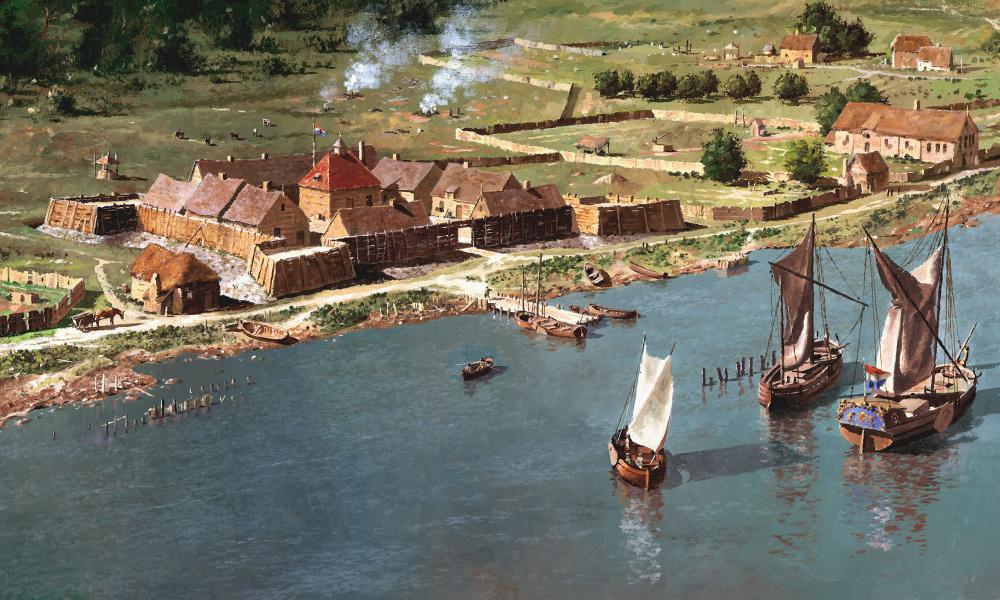
Our first ancestor in North America was Jan Jansen van Nostrand. He is thought to have been the FIRST brewer in the new world! L.F. Tantillo Fine Art – The Beer Wagon (lftantillo.com)
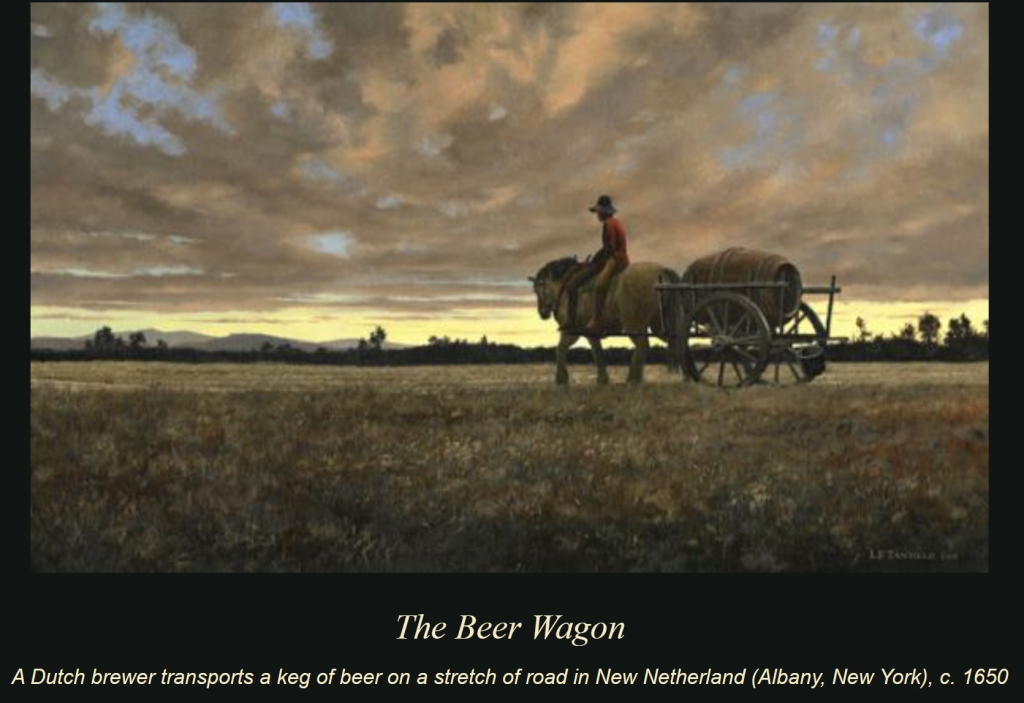
Canada
The first Canadian branch of the van Nostrands, settled in the Hoggs Hollow, York Mills area, of Toronto, and eventually further inland to Vandorf, Ont. Vandorf translates from Dutch as Van Village. This branch seems to have settled on the use of a small “V” in the van, and uses a space between van Nostrand.
A family monument has been erected in the St. John’s Anglican Cemetery, York Mills, ON where there is a white picket fence around the early van Nostrand ancestors burial plot.
Each of the three panels represent one of the three notable historical locations for the Canadian branch. Nordstrand, Rensselaerswyck, and York Mills. The inscription on the monument reads:
“In 1638 Jacob Jansen van Nordstrandt emigrated from Nordstrand in North Friesland to Halve Maen in the colony of Rensselaerswyck (now Saratoga, New York). In 1797 his great grandson Cornelius van Nostrand obtained a land grant in Markham township and came to Upper Canada as a United Empire Loyalist eventually settling on a farm close to this site in York Mills. Most of the van Nostrand descendants are memorialized in this family plot. In 2005 seven generations later this monument was erected to commemorate the Canadian Branch of the family which has spread across the country and beyond “
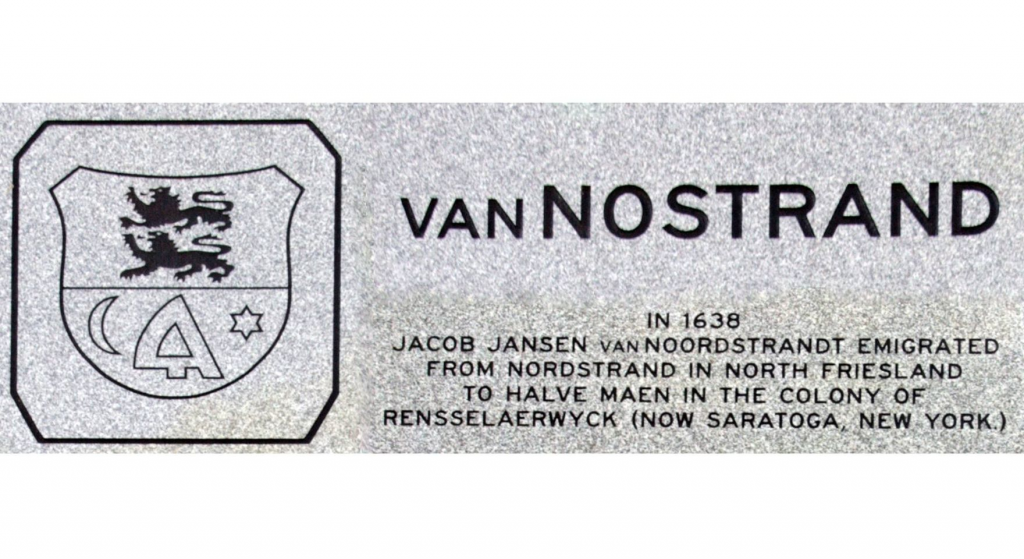
Some of the Vandorf van Nostrands have spread all across Canada.
- Nova Scotia: Neil sent his resume to various provinces after he graduated with his master’s degree in biology. Nova Scotia was the first to offer him a good job, so that is where he went.
- Newfoundland: Bob enjoyed a lengthy forestry career there.
- British Columbia: Dick, decided to try “homesteading” in the wilds of Northern BC. Homesteaders essentially get low cost land if they convert 160 acres of timber into farmland.
Famous vanNostrands
Based on Wikipedia’s measurement of notable people:
- Amy Van Nostrand (born 1953), American actress
- Burr Van Nostrand, American composer (born 1945)
- David Van Nostrand (1811–1886), American publisher
- John Van Nostrand (1961–1984), American tennis player
- Kevin VanNostrand (born 1987), American kickboxer
- Molly Van Nostrand (born 1965), American tennis player
- Wally Van (born Charles Wallace Van Nostrand; 1880-1974), American actor and director
- Nostrand Avenue and subway station, in Brooklyn, NY, USA.
- Van Nostrand’s Scientific Encyclopedia, 1938 encyclopedia of science
- The Van Nostrand Tiara, 1913 silent film
- Van Nostrand Reinhold, an American publisher acquired by John Wiley & Son
- A frequently used alias by the character Cosmo Kramer in the American sitcom Seinfeld
Special Beverage
Nordstrand is the origin of a locally famous alcoholic beverage, the Pharisäer (Pharisee), which the islanders developed in 1872 to be able to drink alcohol in the presence of local pastor Georg Bleyer, who preached abstinence. It is made from hot strong coffee, sugar, dark rum (4 cl of 54% vol.) and whipped cream (to prevent the alcohol from evaporating, so that it could not be smelled). The pastor got the only cup without rum, but one day the cups got mixed up. When he discovered the deceit he exclaimed “Ihr Pharisäer!” (“You Pharisees!”, connoting: “hypocrites”). Hence the name.[5][6]
14 Generations
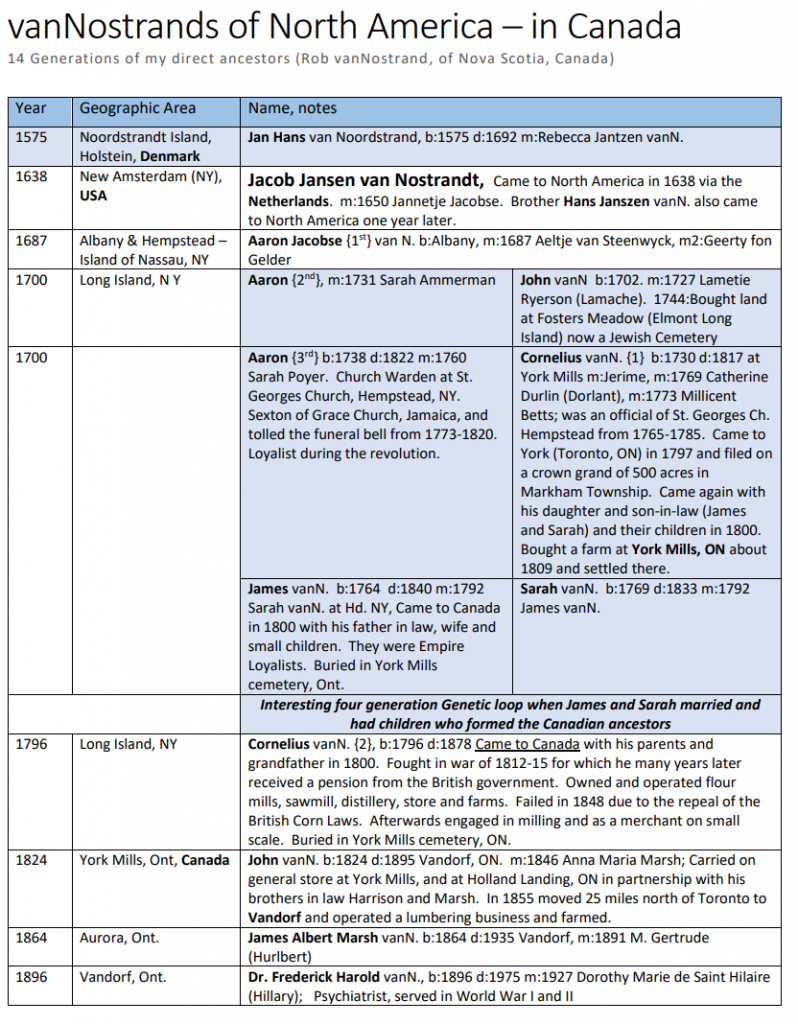
Historical Art Storyboard
This historically based painting, depicts the stark contrast of the 1634 storm with the simple farming lifestyle of the island.
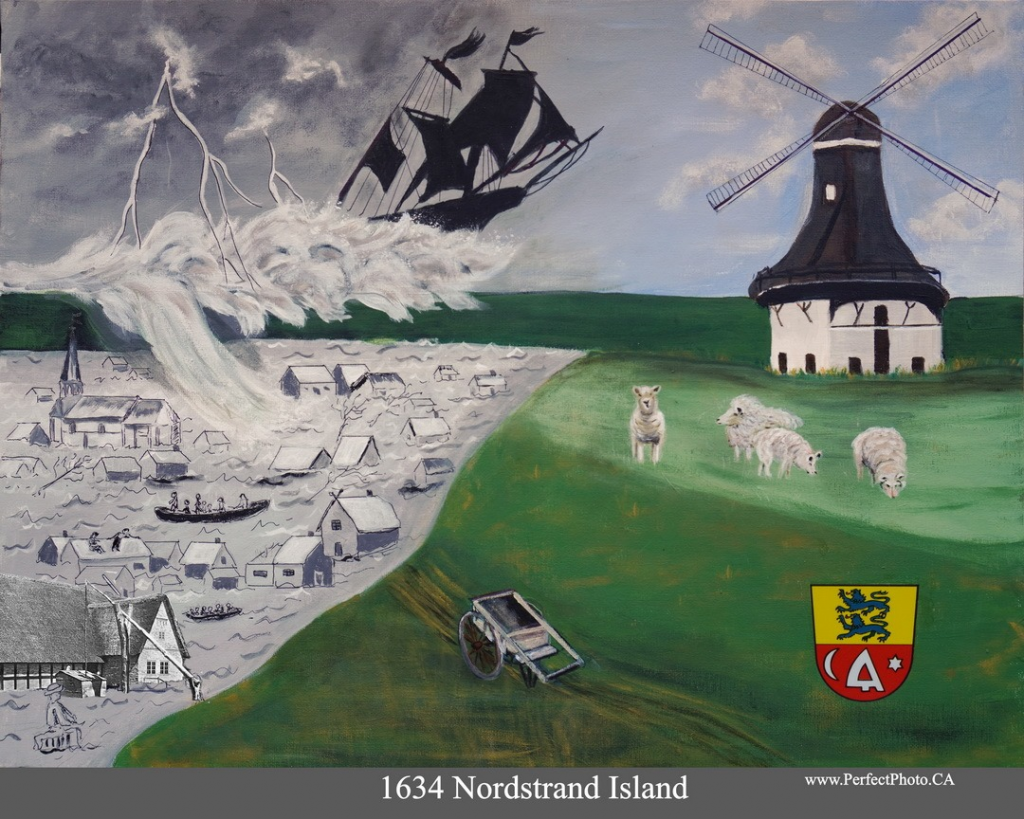
Here’s the story that goes with it:
Nordstrand Island – Historical Art Storyboard
In 1634 a huge storm, split my vanNostrand / van Nostrand ancestral homeland, Nordstrand Island, into three islands. The original island was reduced from about 30 km long to about 12 km. Of the original 6,000 inhabitants, only 1,000 survived. My ancestors were among them, two brothers, who eventually sailed to “New Amsterdam” (present day New York City) in 1638, from Amsterdam. The town of Rungholt was totally obliterated by the storm.
This image is a historical “storyboard” / collage / tribute to the island and its people. The island is located in present day Germany, just below Denmark. That area was ruled by Danish kings and had Dutch influences at the time. The crest / coat of arms appears to be associated with the island (from a 1998 island postcard) and has been adopted by the Canadian branch of the vanNostrands’ as their own and now appears on a massive memorial located in St. John’s Cemetary in Toronto, Ontario, Canada which has one granite arm pointing directly towards Nordstrand.
The present-day island is now connected to the mainland via a causeway. Ferries connect Nordstrand to Pellworm Island and Nordstrandischmoor now. The island is primarily a fishing and farming area for sheep and cattle. The flat protected dike lands continue to be protected from the terror of the North Sea ocean. Most of the old traditional bell-shaped Dutch windmills have been replaced with modern day wind turbines. The one shown here is a tourist shop / destination, large enough for the shop keeper to have a two storey home underneath.
The thick thatched roofs which were used in the area can be seen today in the barn museum and a few specialty places, shown with its simple water well and bucket arrangement. (lower left corner).
The Nordstrand – Odenbüll Churchsurvived the 1634 storm and many others prior to that. It has some stone panels on the exterior of the church with reference to that great flood – the steeple on the church of the village, just below the lightning is the same style.
Some creative artistic liberty has been taken about the depiction of the flooded town between two dikes here. Most dikes protect large flat lowlands. Also, a “painted” hand cart would be unlikely, but it adds a bit of colour to the image. The ship depicted in the big wave is from that era and would be similar to the one that the vanNostrand brothers came to North America on. It was placed there more as a fanciful flourish
The original 24” x 18” acrylic painting by Donna Morris, of Dartmouth, Nova Scotia, Canada was commissioned by Rob vanNostrand, of Halifax, Nova Scotia, Canada, based on family history research. The digital version of the original art work has been augmented with some digital refinements by Rob and is available to anyone interested in 18×24” or 8×10” for a small royalty fee for the artist.
Other genealogy articles
You may enjoy reading some of our other genealogy related articles.



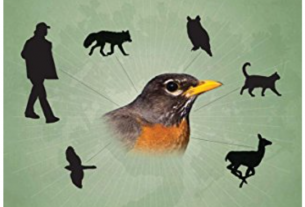

I believe we are related